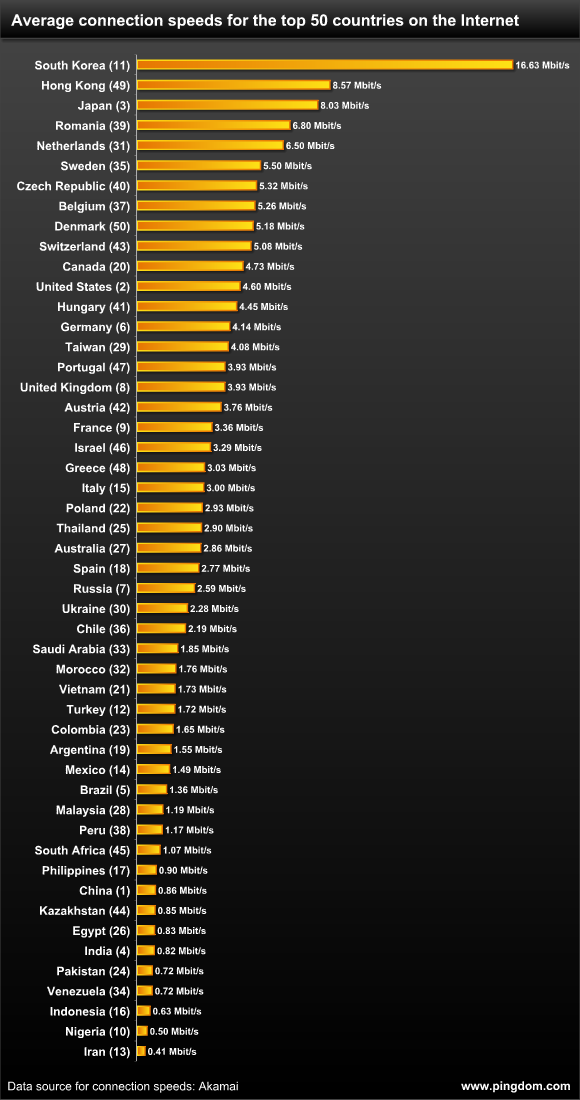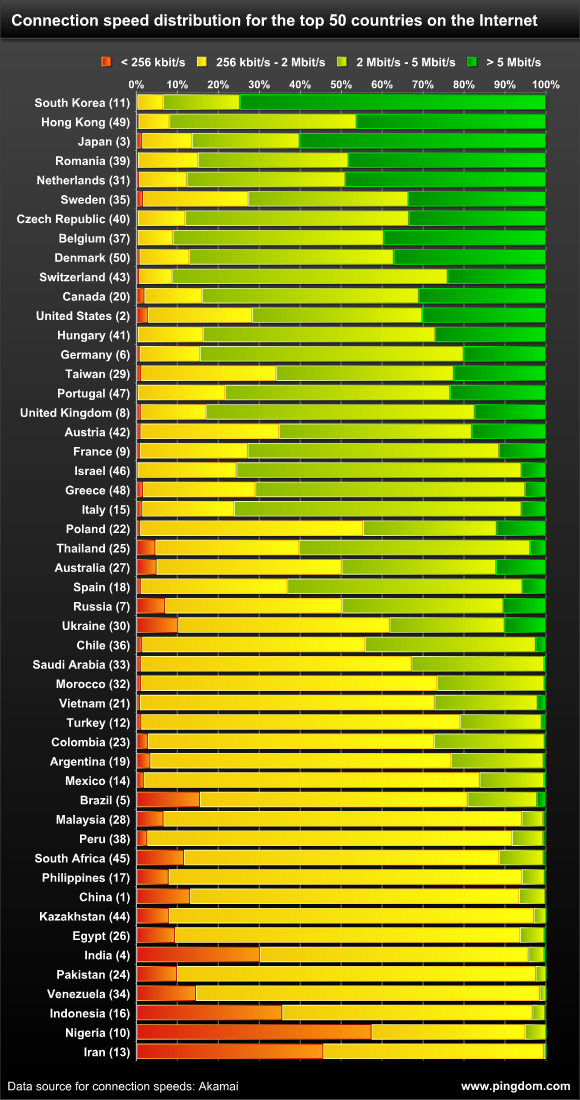How fast are Internet connections across the world? How fast are they in your country?
This article examines the real-world connection speeds for people in the top 50 countries on the Internet, i.e. the countries with the most Internet users.
This list of countries ranges from China at number 1 with 420 million Internet users, and Denmark at number 50 with 4.75 million Internet users. We’ve included this ranking within parenthesis next to each country in the charts below for those who want to know.
These 50 countries together have more than 1.8 billion Internet users.
Why connection speeds matter
Why would you be interested in knowing how Internet connection speeds are distributed among various countries? Here’s why:
- As an Internet user, you can get an idea of how your own Internet connection speed holds up against others in your country.
- As a Web service provider or website owner, you get an idea of what kind of Internet connection speeds your customers are likely to have in different countries. This is highly relevant if you want them to have a positive user experience. This naturally applies to web developers in general as well, who should be well aware of the capacity of people’s Internet connections.
Thanks to data directly from the world’s largest CDN provider, Akamai, we were able to create this report for you. Real connection speeds for Internet users from all over the world. The data is from the second quarter of 2010, so it’s up to date.
(Just in case you don’t know about them, Akamai is the big dog among content delivery network (CDN) providers. The company has servers all over the world and reportedly can handle as much as 15-20% of all Web traffic on any given day. This puts Akamai in a unique position since they can measure actual download speeds all over the world on a consistent basis.)
Average connection speeds
Before we go on to see how each country’s connection speeds are distributed, let’s look at the average connection speed for each country.
As we mentioned before, the number you see within parenthesis next to each country is its worldwide rank in terms of Internet users, i.e. its size on the Internet. The chart is sorted by the average connection speed.

Some observations:
- South Korea, as is well known, is something of an Internet speed king, and that’s made abundantly clear in this chart. At an average connection speed of almost 17 Mbit/s it thoroughly outclasses the competition.
- China, although the largest country on the Internet, still lags behind when it comes to Internet connection speeds. Its average of 0.86 Mbit/s is far below the world average of 1.8 Mbit/s (see below).
- And speaking of China, Hong Kong, technically a part of China but separated in most surveys for statistical purposes, is clearly far ahead of its mother country. With Hong Kong’s average connection speed of 8.6 Mbit/s, it’s second only to South Korea.
- It’s also interesting that all three top positions are in Asia.
- Of the top 10 in this “speed list,” three are from Asia, and seven from Europe.
- Canada beats the United States, barely, with 4.7 Mbit/s versus 4.6 Mbit/s.
Worldwide averages
The average connection speed for Internet users worldwide, not just among these 50 countries, but all countries, is an average of 1.8 Mbit/s. As an average, this is actually pretty good, but as you’ve seen, there are plenty of extremes in either direction.
And here’s how the various connection speeds are distributed. Once again, this is not among these 50 countries, this is for the world seen as a whole (from Akamai’s perspective).

It’s quite encouraging that as many as 22% of the connections are 5 Mbit/s or faster, and even more that more than half of all connections are 2 Mbit/s or faster.
Connection speed distribution
Now on to the prettiest of these charts… What you see here below is how the connection speeds of each country are distributed, just as in the worldwide chart. It’s great for giving you a good overview of the situation in each country, since an overall average can only tell you so much.

The country list is sorted by average connection speed.
As this chart shows, the slowest connection types (less than 256 kbit/s) have almost been eradicated in many countries. However, in many developing nations these still make up a significant portion of the connections.
Real connection speeds are what matter
The speeds in this article are actual connection speeds. We’re not showing what people are paying for, we’re showing what kind of real-world speeds they are actually getting. After all, we all know that ISPs don’t always deliver the kind of connection speeds that they promise in their ads.
As we mentioned earlier, Akamai was kind enough to provide us with the connection speed data for this article, which made all the difference. (A big thank you to David Belson at Akamai for his help.)
So now that you have this report in front of you, why not take a close look at how fast the Internet is in your country? And how does your own connection measure up?
Data sources: Akamai for connection speeds, Internet World Stats for Internet user numbers.
We’ll be doing at least one more post based on the data we got from Akamai, so keep your eyes open.



























